Data is the backbone of modern business strategy, but many companies struggle to turn raw information into real results. Even with better ways to collect data, making it useful for decisions remains challenging.
This guide covers 10 business intelligence best practices that help align data systems with decision-making so that companies can build data-driven operations.
The Future of Business Intelligence in 2025
Businesses today rely on smart analytics tools instead of outdated reporting systems. These new platforms can predict trends and instantly analyze data. However, upgrading technology alone isn’t enough, companies must also rethink how they apply data to their decision-making process.
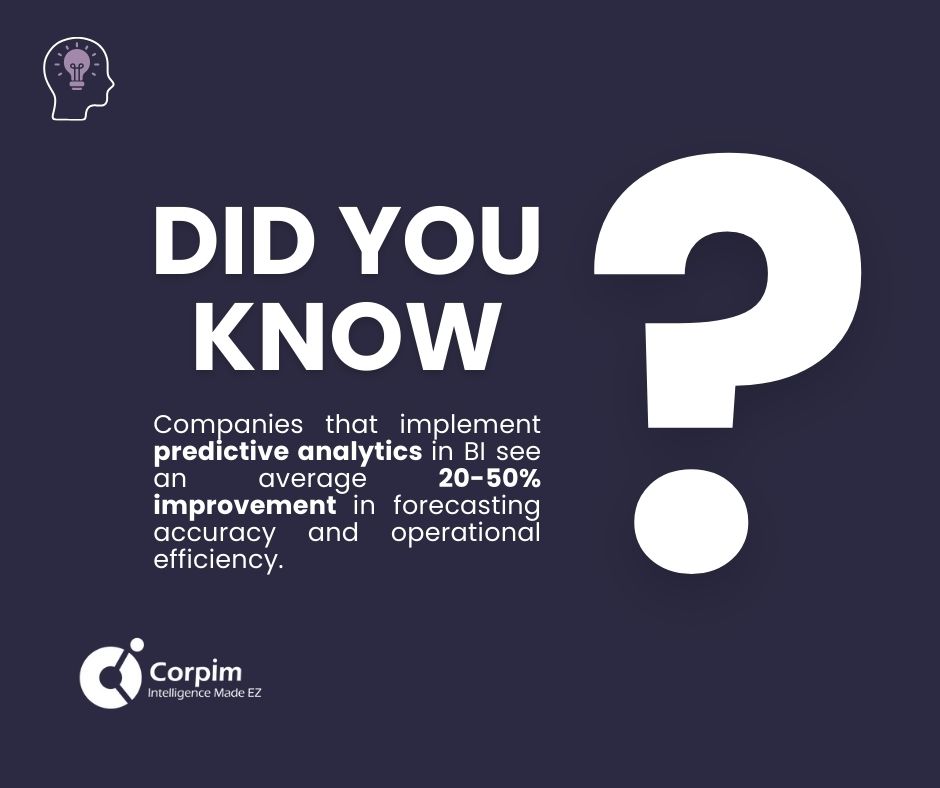
Modern tools help teams move from simply reacting to data to using it to plan ahead. However, success doesn’t just come from having powerful platforms. It depends on how well businesses use these tools to achieve real, measurable results.
Consider how business intelligence tools have evolved:
| Era | Primary Focus | Key Capabilities | Business Impact |
| Traditional BI (Pre-2020) | Historical reporting | Static reports, basic dashboards | Limited reactive decisions |
| Modern BI (2020-2024) | Real-time analytics | Interactive visualization, self-service analytics | Data-driven operations |
| Next-Gen BI (2025+) | Predictive insights | AI-powered analysis, automated recommendations | Strategic advantage |
This evolution has made business intelligence more critical than ever for maintaining competitive advantage and operational efficiency.
10 Essential Business Intelligence Best Practices for 2025
1. Strategic Alignment of Business Intelligence Initiatives
Business intelligence implementation shouldn’t begin with choosing tools for designing dashboards. Instead, it starts with a clear understanding of your organization’s strategic objectives and how data can help achieve them.
Effective business intelligence strategy requires alignment between your data capabilities and business goals.
Many organizations jump into business intelligence projects without this crucial foundation, leading to expensive solutions that don’t address core business needs. A well-aligned business intelligence strategy answers key questions:
- What specific business problems are we trying to solve?
- Which metrics directly impact our strategic objectives?
- How will we measure the success of our BI implementation?
Here’s how this alignment looks across different industries:
| Industry | Strategic Goals | BI Focus Areas | Key Metrics |
| Automotive Service | Customer retention, Service efficiency | Service performance tracking, Customer insights | Time per service, Customer return rate |
| Healthcare | Patient outcomes, Resource optimization | Patient care analytics, Resource utilization | Length of stay, Resource allocation efficiency |
| Manufacturing | Production efficiency, Quality control | Process monitoring, Predictive maintenance | OEE, Defect rates |
| Financial Services | Risk management, Client satisfaction | Portfolio analysis, Risk assessment | Risk exposure, Client retention |
- Learn more about aligning BI with business strategy
2. Data Quality Management and Integration
The foundation of effective business intelligence lies in data quality. Even the most sophisticated BI tools can’t compensate for poor-quality data. Organizations need a comprehensive approach to data management that ensures accuracy, consistency, and reliability across all data sources.
Data quality management involves several critical components:
| Component | Purpose | Key Activities | Success Metrics |
| Data Validation | Ensure accuracy | Automated checks, Data cleansing | Error reduction rate |
| Data Integration | Create unified view | Source connection, Data mapping | Integration success rate |
| Data Governance | Maintain standards | Policy enforcement, Access control | Compliance rate |
| Data Monitoring | Track quality | Real-time monitoring, Issue alerts | Data quality score |
- Explore our approach to data quality management
3. Technology Selection and Implementation
Choosing the right business intelligence tools requires careful consideration of your organization’s specific needs, technical capabilities, and growth plans. The market offers numerous options, from specialized industry solutions to comprehensive enterprise platforms.
Key considerations for technology selection:
| Factor | Description | Impact | Considerations |
| Scalability | Ability to grow | Future expansion support | Growth projections |
| Integration | Connection with existing systems | Operational efficiency | Current technology stack |
| User Experience | Ease of use | Adoption rate | User technical proficiency |
| Security | Data protection | Risk management | Compliance requirements |
Industry-specific considerations:
| Industry | Key Requirements | Recommended Features | Integration Needs |
| Automotive | Multi-location support | Real-time inventory tracking | Shop management systems |
| Healthcare | HIPAA compliance | Patient data security | EHR systems |
| Manufacturing | Real-time monitoring | Process automation | ERP systems |
| Financial | Regulatory compliance | Risk analytics | Trading platforms |
- Discover our industry-specific BI solutions
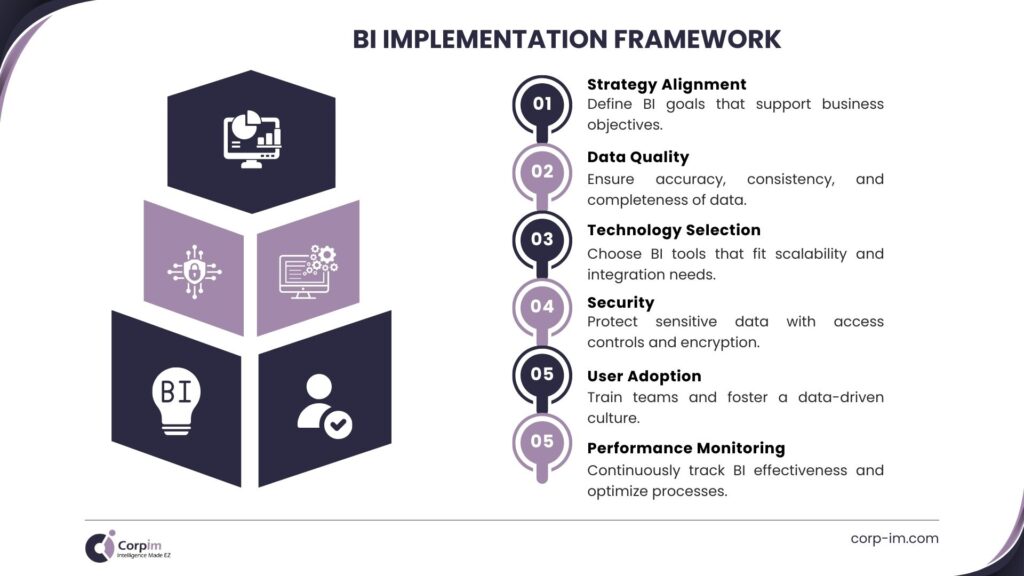
4. Security Architecture and Compliance Framework
Business intelligence systems often handle sensitive data that requires robust protection. Modern security challenges demand a comprehensive approach that goes beyond basic access controls. Organizations need to implement layered security measures while maintaining data accessibility for authorized users.
Security considerations vary by industry and data type:
| Security Layer | Purpose | Implementation | Monitoring |
| Access Control | User authorization | Role-based access | Access logs |
| Data Protection | Information security | Encryption, Masking | Security alerts |
| Compliance | Regulatory adherence | Policy enforcement | Audit trails |
| Incident Response | Risk management | Response protocols | Threat detection |
Industry-specific security requirements:
| Industry | Regulatory Requirements | Key Security Measures | Risk Factors |
| Healthcare | HIPAA, HITECH | PHI protection, Audit logs | Patient data exposure |
| Financial | SOX, GDPR | Transaction security | Financial fraud |
| Automotive | PCI DSS | Customer data protection | Payment info theft |
| Manufacturing | ISO 27001 | IP protection | Trade secret loss |
- Learn about our secure BI implementation approach
5. Data Visualization and Dashboard Design
Effective business intelligence relies heavily on how data is presented to end users. The best insights are worthless if they’re not communicated clearly. Modern visualization techniques transform complex data into intuitive, actionable insights that drive decision-making.
Key principles of effective dashboard design:
| Principle | Description | Benefits | Implementation |
| Clarity | Clear data presentation | Quick understanding | Simple layouts |
| Hierarchy | Important info prominence | Focus on priorities | Visual hierarchy |
| Interactivity | User engagement | Deeper insights | Drill-down capabilities |
| Consistency | Standardized design | Easy navigation | Design systems |
Industry-specific visualization needs:
| Industry | Key Visualizations | User Types | Update Frequency |
| Manufacturing | Production lines | Floor managers | Real-time |
| Healthcare | Patient flow | Clinical staff | Daily |
| Financial | Market trends | Analysts | Real-time |
| Automotive | Service metrics | Store managers | Hourly |
- Explore our BI visualization capabilities
6. Building a Data-Driven Culture
Business intelligence success depends as much on organizational culture as it does on technology. Creating a data-driven culture requires systematic change management and continuous reinforcement of data-driven decision-making practices.
Components of a data-driven culture:
| Component | Purpose | Implementation Steps | Success Metrics |
| Training | Skill development | Regular workshops | Competency levels |
| Leadership | Strategic direction | Executive sponsorship | Adoption rates |
| Process Integration | Workflow embedding | SOP updates | Usage metrics |
| Recognition | Behavior reinforcement | Success sharing | Employee engagement |
Change management framework:
| Phase | Activities | Stakeholders | Deliverables |
| Awareness | Communication campaigns | All employees | Understanding metrics |
| Learning | Training programs | Department heads | Skill assessments |
| Adoption | Practice integration | Team leaders | Usage reports |
| Reinforcement | Success celebration | Organization | Performance reviews |
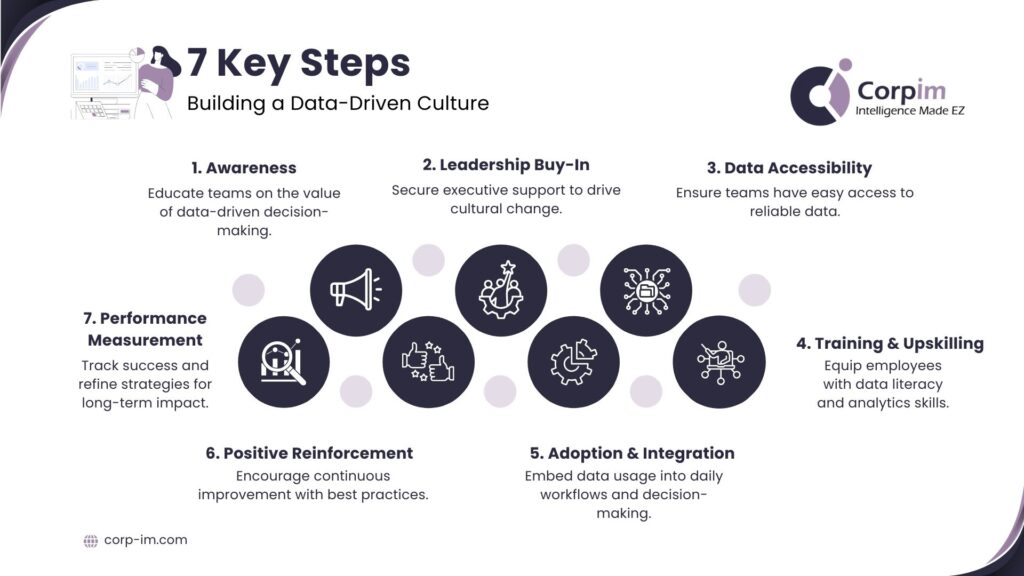
7. Advanced Analytics and Predictive Capabilities
Modern business intelligence goes beyond reporting historical data. Predictive analytics and machine learning capabilities enable organizations to anticipate trends and make proactive decisions. This forward-looking approach transforms business intelligence from a reporting tool into a strategic asset.
Advanced analytics capabilities:
| Capability | Business Value | Implementation | Use Cases |
| Predictive Models | Future insights | ML algorithms | Demand forecasting |
| Pattern Recognition | Trend identification | AI analysis | Behavior analysis |
| Anomaly Detection | Risk management | Real-time monitoring | Fraud prevention |
| Optimization | Process improvement | Advanced algorithms | Resource allocation |
Industry applications:
| Industry | Predictive Use Cases | Benefits | ROI Metrics |
| Automotive | Service demand forecasting | Optimal staffing | Labor efficiency |
| Healthcare | Patient admission prediction | Resource planning | Cost reduction |
| Manufacturing | Equipment maintenance | Downtime reduction | Maintenance savings |
| Financial | Market trend analysis | Investment optimization | Return rates |
- Discover our advanced analytics solutions
8. Scalable Infrastructure Design
As organizations grow, their business intelligence needs evolve. A scalable infrastructure ensures your BI system can grow with your organization while maintaining performance and reliability. This requires careful planning and architecture that anticipates future needs.
Infrastructure considerations:
| Component | Purpose | Scalability Factors | Performance Metrics |
| Data Storage | Information management | Storage capacity | Query response time |
| Processing Power | Analysis capability | Computational resources | Processing speed |
| Network | Data transmission | Bandwidth allocation | Data transfer rates |
| User Access | System utilization | Concurrent users | System response time |
Architecture models for different scales:
| Organization Size | Recommended Architecture | Key Features | Growth Path |
| Small Business | Cloud-based solution | Pay-as-you-go | Feature addition |
| Mid-Market | Hybrid architecture | Flexible scaling | Resource expansion |
| Enterprise | Distributed systems | High availability | Geographic expansion |
| Global | Multi-region deployment | Global redundancy | Market expansion |
- Learn about our scalable BI solutions
9. Performance Monitoring and Optimization
Effective business intelligence requires continuous monitoring and optimization to ensure it delivers value. This involves tracking both system performance and business impact metrics to identify areas for improvement.
Key performance indicators:
| Category | Metrics | Monitoring Frequency | Action Triggers |
| System Performance | Response time | Real-time | Degradation alerts |
| User Engagement | Usage patterns | Weekly | Adoption initiatives |
| Business Impact | ROI measures | Monthly | Strategy adjustment |
| Data Quality | Accuracy rates | Daily | Correction protocols |
Industry-specific monitoring needs:
| Industry | Critical Metrics | Monitoring Focus | Response Plans |
| Healthcare | Patient data accuracy | Real-time access | Emergency protocols |
| Financial | Transaction speed | Market data sync | Failover systems |
| Manufacturing | Production metrics | Process control | Quality alerts |
| Automotive | Service tracking | Customer satisfaction | Service optimization |
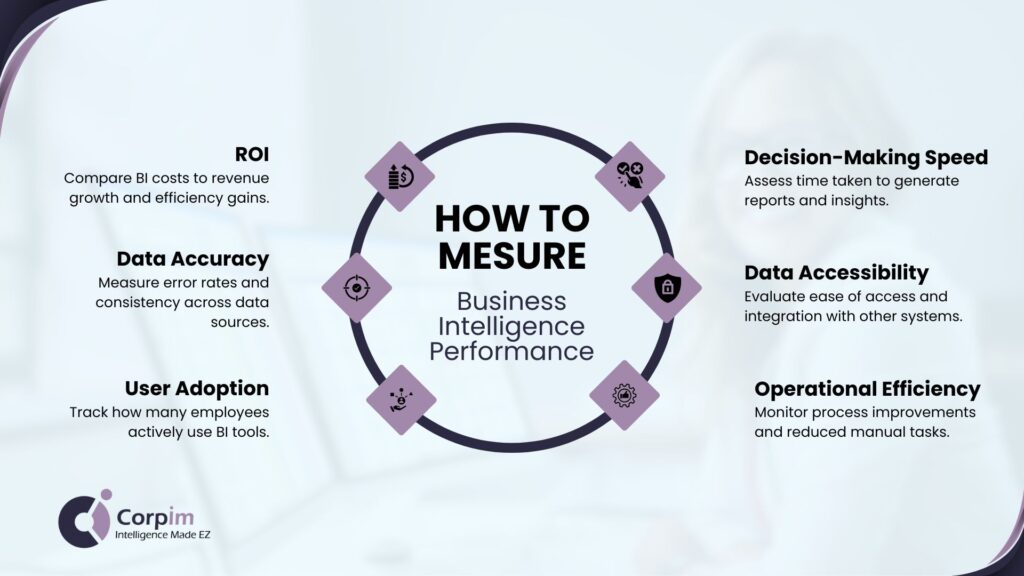
10. Innovation and Future-Proofing
Business intelligence continues to evolve rapidly. Staying current with emerging technologies and trends ensures your BI investment remains valuable over time. This requires a balanced approach to innovation that combines stability with forward-thinking adoption of new capabilities.
Emerging technologies impact:
| Technology | Business Impact | Implementation Timeline | Risk Level |
| AI/ML | Automated insights | 12-18 months | Medium |
| IoT Integration | Real-time data | 6-12 months | Low |
| Natural Language Processing | Accessibility | 12-24 months | Medium |
| Augmented Analytics | Enhanced insights | 18-24 months | High |
Innovation roadmap components:
| Component | Purpose | Implementation Steps | Success Metrics |
| Technology Assessment | Evaluation | Regular reviews | Adoption rate |
| Pilot Programs | Testing | Controlled rollouts | ROI measures |
| Skills Development | Capability building | Training programs | Competency levels |
| Partner Ecosystem | Innovation access | Partnership development | Solution integration |
- Stay updated on BI trends
Implementation Success Stories of BI Best Practices:
Real-world examples demonstrate how organizations have successfully implemented these business intelligence best practices:
Multi-Location Automotive Service Provider
| Challenge | Solution | Results | Timeline |
| Fragmented data | Centralized BI platform | 40% efficiency gain | 6 months |
| Manual reporting | Automated analytics | 25% cost reduction | 3 months |
| Inventory management | Predictive ordering | 30% waste reduction | 9 months |
Regional Healthcare Network
| Challenge | Solution | Results | Timeline |
| Patient tracking | Real-time monitoring | 35% better care coordination | 12 months |
| Resource allocation | Predictive scheduling | 28% resource optimization | 8 months |
| Compliance reporting | Automated compliance | 100% reporting accuracy | 4 months |
Frequently Asked Questions About Business Intelligence
How does business intelligence differ from data analytics?
Business intelligence focuses on using historical and current data to inform present-day decisions and operations. While data analytics often explores predictive models and future scenarios, business intelligence tools emphasize real-time reporting, dashboards, and operational insights.
Think of business intelligence as your organization’s current snapshot and recent history, helping you understand where you are and how you got there.
- Learn more about the differences between BI and analytics
What ROI can I expect from implementing business intelligence solutions?
Return on investment varies by industry and implementation, but our clients typically see:
- 15-30% reduction in operational costs
- 20-40% improvement in decision-making speed
- 25-35% increase in team productivity The key to maximizing ROI lies in proper implementation and alignment with business objectives. Most organizations achieve positive ROI within 12-18 months of implementing comprehensive business intelligence solutions.
How long does it take to implement a business intelligence system?
Implementation timelines depend on several factors, including:
- Organization size and complexity
- Current data infrastructure
- Specific industry requirements
- Scope of implementation Typically, basic implementation takes 3-6 months, while comprehensive enterprise solutions might require 8-12 months. However, with modern cloud-based business intelligence platforms, you can often start seeing benefits within weeks of beginning implementation.
What security measures should business intelligence systems include?
Modern business intelligence platforms require robust security measures, including:
- Role-based access control
- Data encryption at rest and in transit
- Regular security audits
- Compliance with industry standards (HIPAA, GDPR, etc.) The specific requirements depend on your industry and data types, but security should always be a top priority in any business intelligence implementation.
How can I ensure user adoption of business intelligence tools?
Successful adoption requires a combination of:
- Intuitive user interfaces tailored to different user roles
- Comprehensive training programs
- Clear demonstration of value to end users
- Regular feedback collection and system optimization Focus on making the business intelligence tools part of daily workflows rather than treating them as separate systems. Start with key stakeholders and gradually expand usage across the organization.
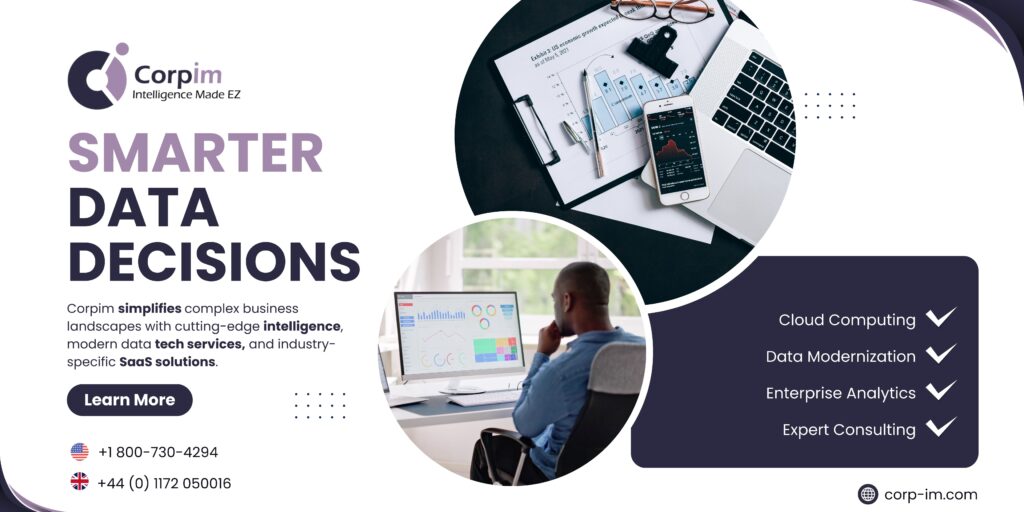
Partner with Corpim for BI Success
Implementing effective business intelligence requires expertise, experience, and the right partner. At Corpim, we combine deep industry knowledge with cutting-edge technology to deliver BI solutions that drive real business value.
Our approach focuses on:
| Aspect | Our Commitment | Your Benefit | Delivery Method |
| Industry Expertise | Sector-specific solutions | Faster ROI | Dedicated teams |
| Technology Leadership | Latest BI capabilities | Future-proof solutions | Regular updates |
| Implementation Support | End-to-end guidance | Smooth adoption | Continuous support |
| Ongoing Optimization | Performance monitoring | Sustained value | Regular reviews |
Ready to transform your organization’s business intelligence capabilities? Contact us to learn how we can help you implement these best practices and achieve your data-driven goals. Start your BI journey with Corpim













